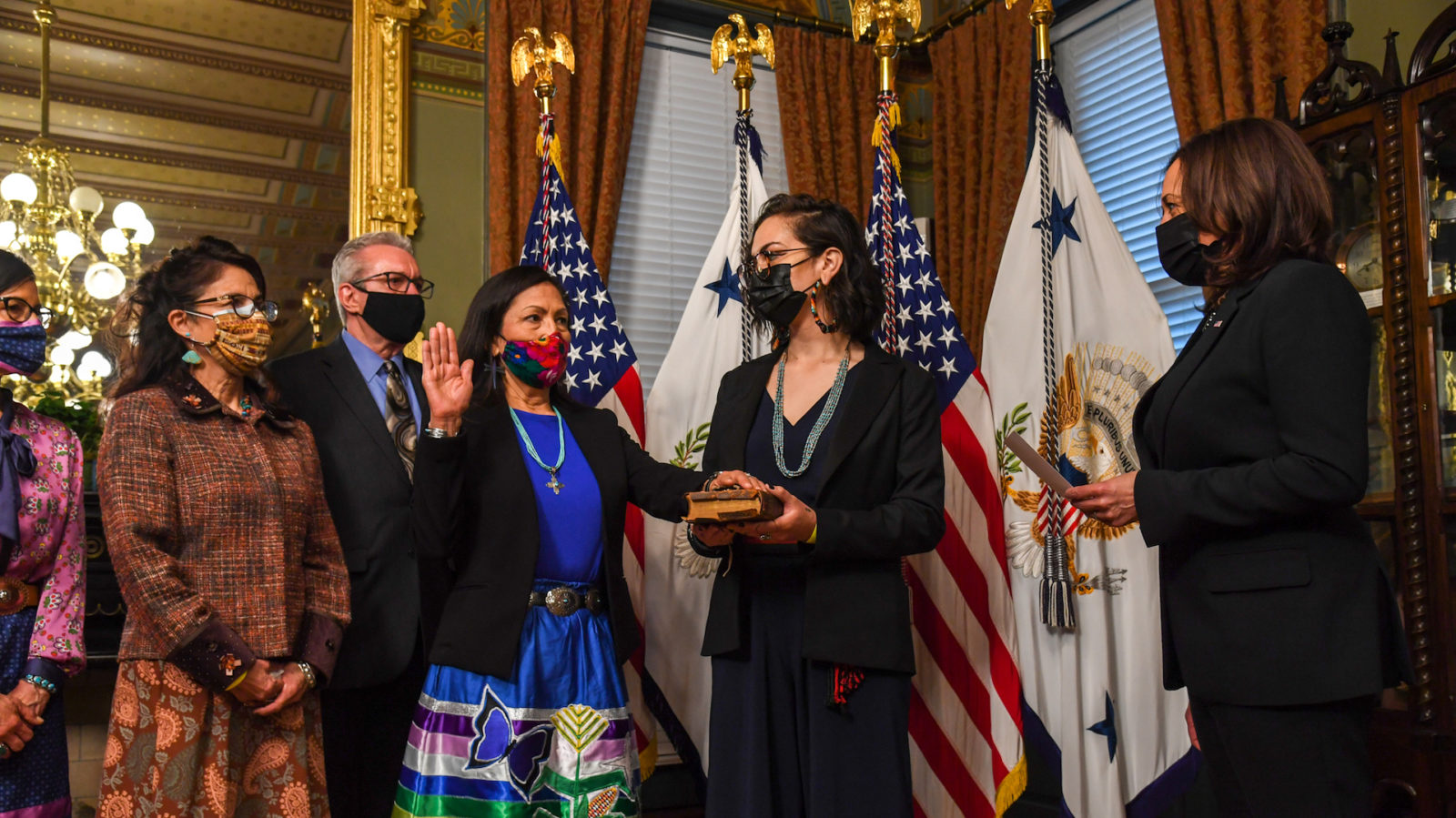On March 15, 2021, Representative Debra Haaland was confirmed for Secretary of the Interior in a historic vote. After a lengthy confirmation process the Senate voted in favor of her confirmation by a margin of 51-40. Senate Democrats voted unanimously to instate her while 40 Republicans voted against it, and only four voted yes.
Secretary Haaland has already begun her work as the head of the Department. Developments in the Department’s fight to end oil and natural gas drilling on federal lands and pushback from fossil-fuel reliant states, like Haaland’s home State of New Mexico, puts her in a uniquely complex position when it comes to leading the agency. This is further complicated by Haaland’s commitment to environmental justice, climate action, and Indigenous rights in the United States.
Significance
Secretary Haaland’s confirmation is historic in both a symbolic and practical sense. Practically, Haaland is the first Native American to act as a secretary for any Executive Departments of the U.S. Cabinet. This is not the first time Haaland has secured a historical role — in 2018 she joined Congress as one of the first two Native American women in the governing body.
Additionally, her position is seen as bringing the true purpose of the Department of the Interior full-circle. The department is responsible for protecting sites that are both ecologically and culturally important, as well as upholding treaties and facilitating relations between the federal government and the 574 federally-recognized Indian Nations in the United States.
Haaland has seen widespread support from a number of organizations as she moves into her new role, including from a number of Native American leaders. In a press release from the All Pueblo Council of Governors (APCG) following her confirmation, former Governor of Laguna Pueblo, Haaland’s nation, and current APCG Chairman Wilfred Herrera Jr. wrote, “We applaud the U.S. Senate for confirming Secretary Deb Haaland to lead the Department of Interior. This confirmation is a defining moment for Indigenous peoples not only in the United States but around the world.” ACPG Secretary and former Governor of Jemez Pueblo, David M. Toledo wrote, “This moment will be remembered as an example that no glass ceiling is unbreakable.”
Her confirmation is also meaningful to those in New Mexico who knew her previously. In a recent call with Climate XChange, New Mexico Representative Angelica Rubio described Haaland as having always been inspiring, noting her work during Obama’s campaign mobilizing Native American communities in New Mexico to vote. Representative Rubio is an environmental justice advocate in the State House, having become intimately aware of the impacts of the fossil fuel industry on the health of both the people and the environment in New Mexico after growing up in the Southeastern part of the state. She hopes that Biden, “because of whom he has surrounded himself with, like Secretary Haaland, will be more bold on issues like climate change, protecting lands for future generations and creating a new [environmental] stewardship for our communities.”
What Secretary Haaland Has Done So Far
Haaland did not delay tackling the issues that are most important to her once she stepped into her new role. She hit the ground running in her new position and has already landed in the news for a number of initiatives and projects she has attached herself to. In early April, she announced the creation of a new unit — the Missing and Murdered Unit — under the Bureau of Indian Affairs, which will aim to address the long-term crisis of Missing and Murdered Indigenous Women (MMIW) in the United States.
She has also continued her path as a climate champion and environmental justice advocate, which she began as a Congresswoman when she became one of the first lawmakers to back the Green New Deal. She recently met with Navajo Nation President Jonathan Nez in Bluff, Utah, to discuss the federal protection of 1.9 million acres of land in Bears Ears under national monument status.
During her trip to Utah, @SecDebHaaland visited Bears Ears national monument, where she met with elected officials, Tribal leaders, and environmental groups. “We are going to listen to every single individual and organization,” the Secretary said.https://t.co/GSz2Yl0pXf
— US Interior Press Team (@USInteriorPress) April 12, 2021
Tension in New Mexico
The Department of the Interior under Biden suspended lease sales in the Gulf of Mexico through an executive order signed soon after the new administration took office. This has effectively halted any new oil drilling on public lands. The move struck some nerves in New Mexico, which is one of the top-10 fossil fuel energy producing states in the U.S. The State is the third-largest producer of oil in the country, with reserves mainly located on federal lands that are covered by the executive order. It is important to note that many of these federal lands are on Tribal lands. However, the Tribes whose land it is have historically not owned the coal plants or received energy from them, and have only reaped benefits through jobs.
The Navajo Nation is an example of this. The situation there is complex in terms of property rights because the Navajo Nation lands holding most of the fossil fuels supplies in the state are also federal lands, complicating the processing of energy development permits. There is also vast potential for renewable energy development on Navajo Nation lands. Therefore, much of the energy resources that power and fund southwestern states like New Mexico, exist on Navajo Nation lands. However, instead of being able to reap the benefits and rewards of these resources, the Nation’s people and ancestral lands have been exploited and left to suffer negative consequences and only reap minor benefits.
It is important to recognize that almost all positive economic aspects linked to these resources have been removed completely from the control of the Nation. A number of coal-fired power plants have operated on Navajo lands for many years. However, the Navajo Tribal Utility Authority notes that not only did the Nation never own or operate any of these plants, but none of the energy generated was provided to Navajo Nation. The only benefits given to the people whose land the stations were built on were coal royalties, lease payments, and possible job opportunities. Nation leaders have expressed that this income is not sustainable for the communities and the land even though the Navajo Nation has long been forced to depend on it for jobs and to fuel their general fund. The Nation now seeks to develop renewable energy that they own and operate in order to reap the long-term benefits, both economically and environmentally.
Fossil fuel production funds large portions of social programs in the state, including education. A recent report found that the total state and local revenue in New Mexico from oil and gas production in fiscal year 2020 added up to $2 billion. Out of fear of losing this major source of state funding, Governor Lujan Grisham recently sent a letter to President Biden arguing that the federal government’s actions seeking to halt oil extraction on public lands would cause tremendous economic losses to New Mexico. She asked Biden to grant the state energy transition credit for actions the state has taken to address pollution and the passing of its landmark Energy Transition Act. Grisham writes “We ask that our state-level efforts to combat climate change and ensure more responsible oil and gas development be considered and that New Mexico be granted energy transition credit as you chart a path forward on climate change and oil and gas leasing in particular.”
New Mexico is not the only state pushing back against the ban. A number of Western states have also come forward with concerns, given the large amount of oil-rich federal land in the region. The Western Governors Association sent a letter to President Biden prior to Grisham, expressing similar concerns as those expressed by the New Mexico Governor. They state that, “Climate change mitigation and adaptation strategies that rely on federal land disproportionately affect western states, given the high percentage of federal lands in western states.”
What Secretary Haaland Could Do
Secretary Haaland is in a unique position to navigate this contentious debate, as a 35th generation Native New Mexican and member of the federally recognized Laguna Pueblo Nation.
Stakeholders from her home state have been urging her to act to defend their interests. The New Mexico Oil and Gas Association (NMOGA) has put out a number of statements urging her to take a “balanced approach,” pointing out repeatedly that banning natural gas and oil production on federal lands would be incredibly harmful to New Mexicans.
During her confirmation hearing, Haaland was heavily questioned by Republican lawmakers on her positions regarding fossil fuels and took a more moderate stance than expected, stating “there’s no question that fossil energy does and will continue to play a major role in America for years to come.” The NMOGA saw this in a positive light, saying in a statement that she “set an encouraging tone of collaboration and partnership” in her hearing, and went on to say that they “look forward to working with her […] to proactively combat climate change and ensure our state continues to be a leader in the safe, responsible production of oil and natural gas.” However, she also continued her track record of placing climate action at a high level of importance, noting in her hearing that it must be addressed.
As New Mexico still relies primarily on fossil fuels to fund State programs, it will be interesting to follow how Haaland includes this as a consideration in her work with the Department of the Interior. Her landmark confirmation now past, she is expected to begin making some of the major decisions and processes required by the Department, especially in light of Biden’s pledge to make America carbon neutral by 2050.









